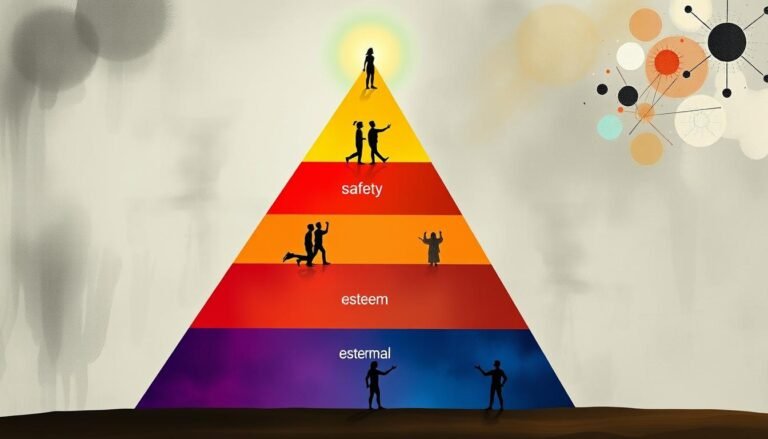Unlock Success with Path-Goal Theory Leadership
What if the key to unlocking your team’s full potential lies not just in your vision but in how well you align your leadership style with their needs? The Path-Goal Theory of leadership suggests this. It was developed by Robert House in the 1970s. This leadership theory highlights how leaders guide their followers to reach goals by changing their behavior based on the situation.
As organizations aim for organizational success, it’s crucial to understand the motivation theory and how to boost team motivation. In this article, we’ll look into the Path-Goal Theory. We’ll see how effective leaders use different styles to motivate their teams.
Key Takeaways
- The Path-Goal Theory focuses on adapting leadership styles to enhance follower motivation and satisfaction.
- There are four main leadership styles: Directive, Supportive, Participative, and Achievement-Oriented.
- Understanding situational factors, such as follower characteristics, is essential for effective leadership.
- Effective leaders clarify the path to goals and remove obstacles to ensure team success.
- Adapting leadership behaviors can significantly impact overall team performance and motivation.
Introduction to Path-Goal Theory
Path-Goal Theory was first introduced by Robert House in 1971. It shows how leaders can boost followers’ motivation to reach goals. This theory believes that leaders make a big difference by giving clear direction and support. Studies have proven that the right leadership style can greatly increase job satisfaction and motivation.
At the heart of Path-Goal Theory is how leaders behave. House and Mitchell (1974) found four main leadership styles: directive, supportive, participative, and achievement-oriented. Leaders pick these styles based on the situation and who they are leading. They consider what their followers like, need, and can do.
Northouse (2016) says it’s key to know your followers to use Path-Goal Theory well. For example, some people like clear rules and do better with a directive leader. Others prefer to make their own choices and do well with a participative leader. The way tasks are set and who has power also affects which style works best.
This theory also talks about how leaders help clear goals and get rid of obstacles. It matches with the expectancy theory of motivation, as noted by Vroom (1964). Leaders boost followers’ confidence in their skills, which can lead to better work and happiness. It’s important for leaders to be flexible and adapt to the situation for Path-Goal Theory to work well.
Understanding the Four Leadership Styles
Path-Goal Theory talks about four main leadership styles. Each style is made to fit the needs of teams and goals. Knowing these styles—Directive, Supportive, Participative, and Achievement-Oriented—helps leaders lead better.
Directive Leadership
Directive Leadership works well for teams that are new or lack experience. Leaders give clear orders and set clear goals. This makes sure everyone knows what to do.
It helps reduce confusion and guides followers to meet goals, especially in tough situations.
Supportive Leadership
Supportive Leadership focuses on the well-being of team members. It creates a caring environment that boosts morale and strengthens bonds. Leaders who support their team encourage teamwork and focus on emotional support and growth.
Participative Leadership
Participative Leadership means involving team members in decisions. Leaders talk to the team before making choices. This brings together different ideas and skills, leading to new ideas and better performance.
This style is great when teamwork is key to solving problems.
Achievement-Oriented Leadership
Achievement-Oriented Leadership sets high goals for followers. Leaders aim to boost confidence and motivation in their teams. They celebrate successes and encourage growth, leading to better performance.
Path-Goal Theory and Organizational Behavior
The Path-Goal Theory helps leaders adjust their styles to boost leadership effectiveness. It was created by Robert House in 1971 and updated in 1996. This theory shows how leadership affects team dynamics. Leaders are key in meeting their team’s needs, which boosts motivation and performance.
Using the Path-Goal Theory means taking action. For example, assessing a team helps spot strengths and weaknesses, improving communication. Setting clear goals motivates the team by making their roles clear. Giving regular feedback and support helps leaders clear the way for their team’s success.
Studies show that good leadership makes employees happier. Sadly, 79% of employees leave because they don’t feel valued by their bosses. By fixing this, leaders can make their teams work better together and stay productive.
The Path-Goal Theory talks about four main leader behaviors: directive, supportive, participative, and achievement-oriented. These behaviors can mix depending on the situation. This flexibility helps teams perform better and builds a team spirit.
Enhancing Motivation with Path-Goal Theory
Path-Goal Theory is a way to boost motivation in teams. Leaders can improve team performance by choosing the right leadership style. This theory includes Expectancy Theory, which links individual performance to motivation.
The Role of Expectancy Theory
Expectancy Theory says people work harder when they think their efforts will get them what they want. Leaders can make teams more motivated by setting clear goals and rewards. This makes reaching goals more likely.
Knowing about Path-Goal Theory’s leadership styles helps leaders pick the best approach for their team and tasks. Each style has its own benefits:
- Directive leadership gives clear instructions, great for new team members or tough tasks.
- Supportive leadership creates a positive work environment, boosting satisfaction and loyalty, especially in stressful or routine tasks.
- Participative leadership gets the team involved, raising motivation and creativity on tough projects.
- Achievement-oriented leadership sets high goals, encouraging a culture of confidence and productivity.
Many American workers feel stressed and unengaged. Half are stressed daily, and only a third feel connected at work. Yet, engaged teams can lead to a 23% profit increase. Disengagement costs the world up to $7.8 trillion in lost productivity.
Using Path-Goal Theory, leaders can better understand team dynamics and meet individual needs. This creates a place where motivation grows.
Adapting Leadership Styles Based on Situational Factors
Leadership success often depends on adapting to different situations. Situational leadership helps us see how various situations need different leadership styles. Leaders must look at task complexity, follower traits, and the environment around them.
The Path-Goal Theory shows how leaders motivate their teams by making goals clear, removing barriers, and making work more satisfying. This approach helps leaders be flexible, changing their methods based on what their followers need and their level of maturity.
The SLII model is another important idea in this topic. It says effective leadership means knowing where followers are in their development. Leaders use different styles—like delegating, participating, selling, or telling—based on how mature their followers are. The key is to understand follower maturity and adjust how you communicate and guide them.
Here’s a table that compares situational leadership and its impact on leadership:
| Leadership Model | Focus | Key Adaptation | Strengths | Challenges |
|---|---|---|---|---|
| Path-Goal Theory | Motivation through clarity and support | Tailoring support to individual needs | Increases follower satisfaction and engagement | Complexity and leader-centric assumptions |
| Situational Leadership Model | Adapting based on follower maturity | Flexible styles for varying maturity levels | Adaptability and ease of application | Potential flaws in decision-making |
| Hersey-Blanchard Model | Aligning leadership style with maturity | Providing suitable levels of guidance | Encourages tailored management approaches | Inapplicability in certain cultures or industries |
In conclusion, effective leadership comes from adapting to the situation. By using theories like Path-Goal Theory, leaders can improve their strategies. This helps them work better with their teams, leading to better engagement and success.
Practical Applications of Path-Goal Theory in Leadership
The Path-Goal Theory of Leadership is used in many areas, like education and technology. Leaders like Sundar Pichai of Google show how changing leadership styles can help meet followers’ needs. This helps achieve goals. The theory includes different leadership styles like directive, supportive, participative, and achievement-oriented. These styles are key to effective leadership.
Case Studies of Successful Leaders
Many case studies show how Path-Goal Theory leads to success in leadership. Leithwood et al. (2020) found that good school leaders develop their talent. This creates a place where people can grow professionally.
During the COVID-19 pandemic, school leaders changed their styles. They used both directive and supportive methods. This helped them reach their goals in tough times.
Sundar Pichai at Google shows the value of adapting to change and the team. He created a team atmosphere that helped Google’s revenue grow from USD 74.5 billion in 2015 to USD 256.7 billion in 2021. This shows how Path-Goal Theory works well in tech, leading to big business wins.
With millennials and Gen Z in the workforce, knowing how to lead is key. Leaders who transform and connect with their teams do well. They meet goals and make their teams feel part of the team. This is what Path-Goal Theory is all about, leading to lasting success.
| Leader | Organization | Application of Path-Goal Theory | Leadership Success Outcome |
|---|---|---|---|
| Sundar Pichai | Participative and Achievement-Oriented | $256.7 billion revenue in 2021 | |
| Arne Sorenson | Marriott International | Supportive and Directive | Maintained employee morale during COVID-19 |
| Mark Zuckerberg | Meta (Facebook) | Directive and Participative | Continued growth in user engagement |
Conclusion
Path-Goal Theory was first introduced in 1971 and has been improved over the years. It offers a strong way to make leaders better. By matching leadership styles with team needs, leaders can make their approach work best. This creates a place where motivation grows.
Knowing about the four leadership styles – Directive, Supportive, Participative, and Achievement-Oriented – is key. Leaders can change their style based on the situation and their team. This flexibility helps leaders make their behavior fit the needs of their organization.
This way, leaders can make their team see goals as reachable and make those goals more appealing. This supports the Path-Goal Theory’s main idea.
In short, the Path-Goal Theory shows how leadership affects teams and organizations. By using this theory’s ideas, leaders can create a motivating place. They can help their teams work together and grow. This approach helps individuals grow and builds a strong base for long-term success.
Source Links
- The Path – Goal Theory: Situational Leadership
- The Best Leadership Insights #2 Path-Goal Theory
- What is Path-Goal Theory?
- House’s Path-goal Theory of Leadership – GeeksforGeeks
- ‘Path-Goal Theory of Leader Effectiveness’ is developed by :
- Why the Path Goal Theory of Leadership is essential at work | SC Training
- Exploring the 4 Leadership Theories: A Comprehensive Overview
- The Path Goal Theory of Leadership: Optimize Your Team – SaaS BPM
- Path–goal theory
- How can you use path-goal theory to motivate your team in project leadership?
- How the Path-Goal Theory of Leadership can Help You Grow as an Executive – Chris Dyer Keynote Speaker
- Situational Leadership Theory and Path-Goal Leadership Theory
- Situational Leadership (Hersey-Blanchard) Model: How It Works
- Toward Success While Tackling the Change in A Pandemic Age: Path-Goal Theory Leadership as a Win-Win Gadget
- Thorough elaboration of path-goal theory of leadership
- Path-Goal Theory of Leadership – Leadership Ahoy!
- Is the Path-Goal Theory that pertains to Leadership actually somewhat flawed?
- A Real-Life Application in a Tech Startup







